Evidence-Based Brief: Addressing Healthcare Shortages in Australia
VerifiedAdded on 2023/04/10
|8
|1721
|176
Report
AI Summary
This report addresses the critical issue of healthcare workforce shortages in Australia, particularly focusing on the nursing profession. It highlights the contributing factors such as job dissatisfaction, heavy workloads, and lack of autonomy. The report explores potential solutions including improved workforce planning, increased funding for training programs, workplace reforms to enhance job satisfaction, and strategies to attract healthcare professionals to rural areas. It emphasizes the importance of a national approach involving government and stakeholders to ensure a sustainable and qualified healthcare workforce capable of meeting the evolving needs of Australia's aging population and increasing prevalence of chronic diseases. The report concludes by stressing the need for effective implementation of these strategies to prevent a major setback in the Australian healthcare system.
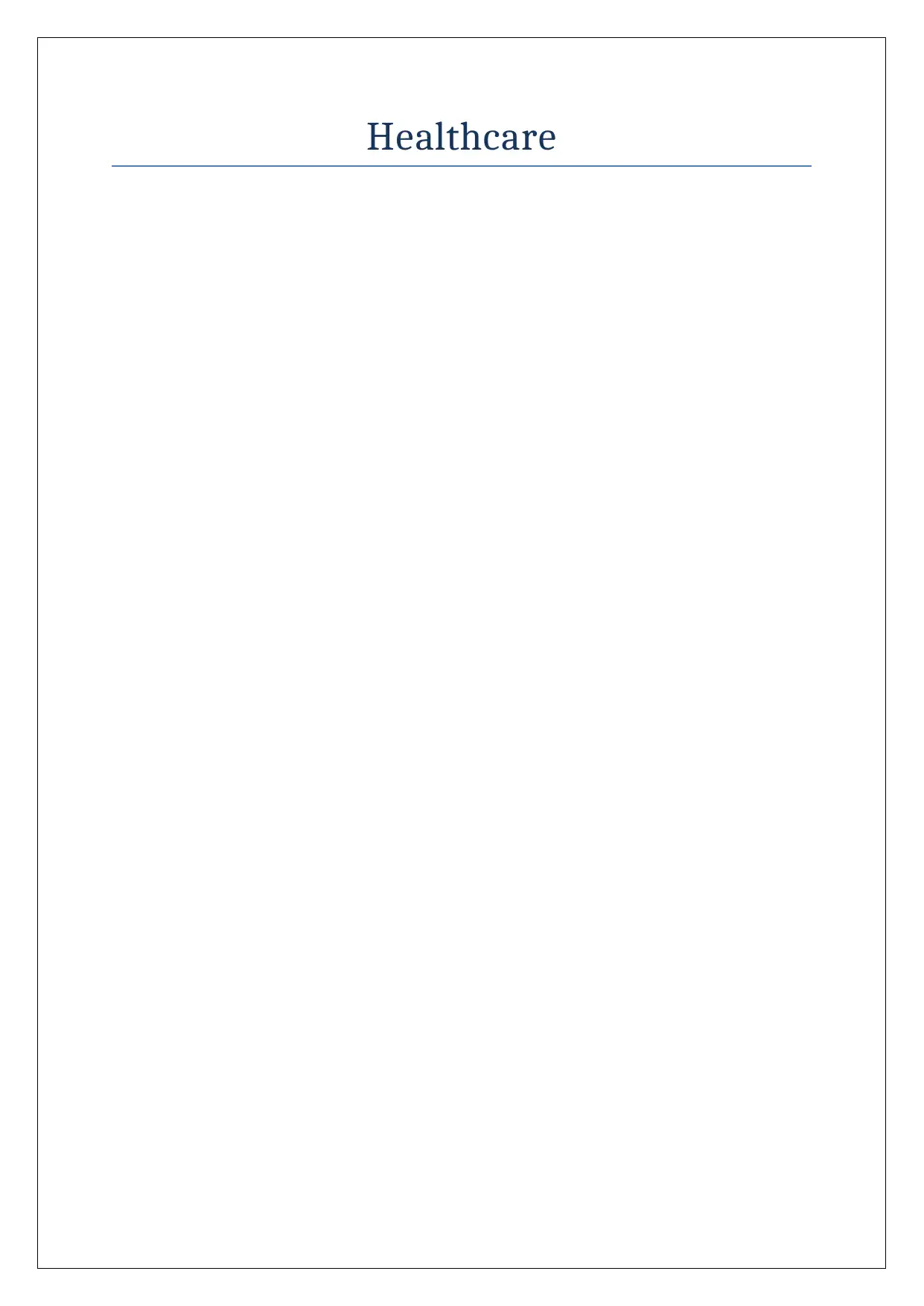
Healthcare
Paraphrase This Document
Need a fresh take? Get an instant paraphrase of this document with our AI Paraphraser
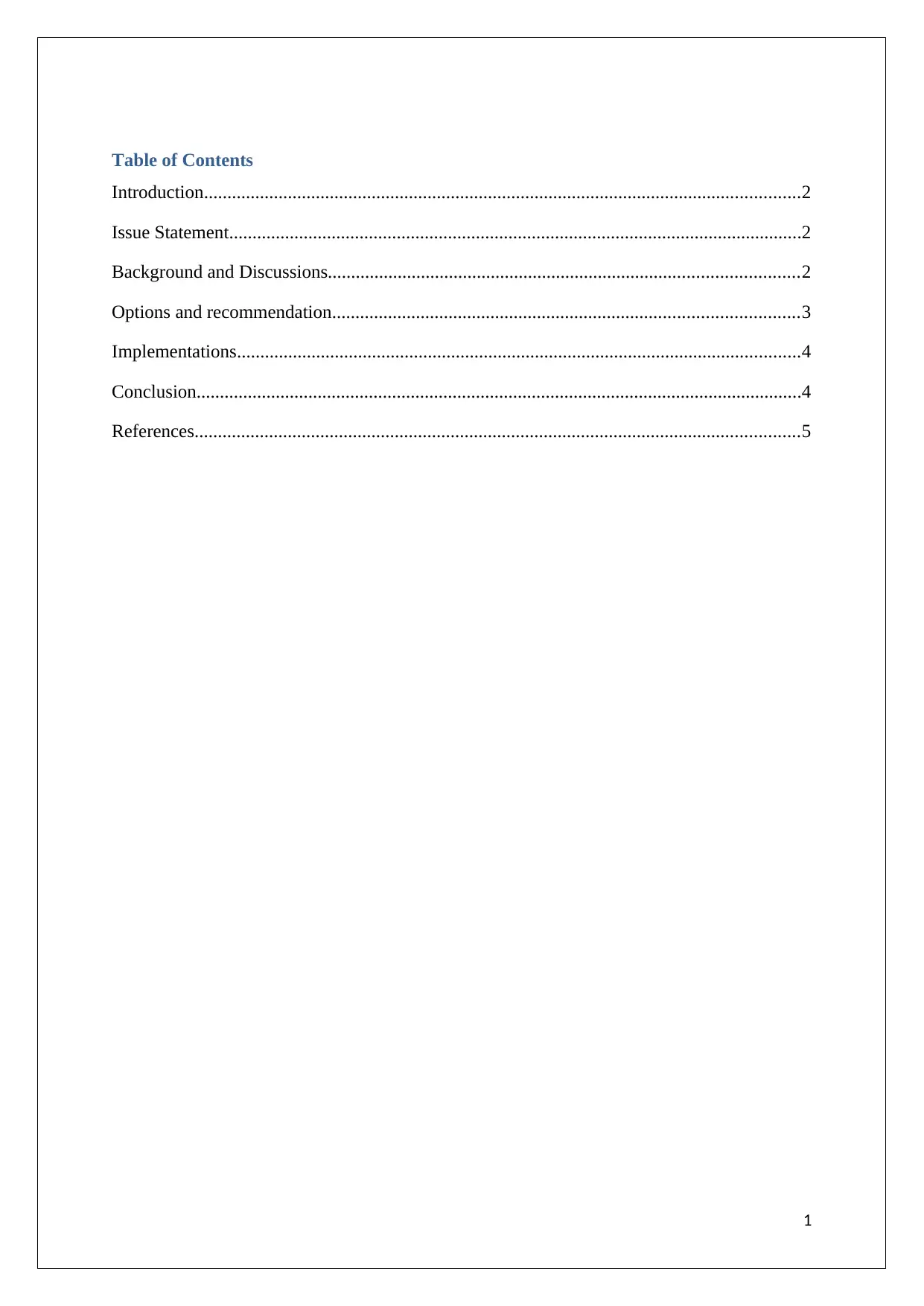
Table of Contents
Introduction................................................................................................................................2
Issue Statement...........................................................................................................................2
Background and Discussions.....................................................................................................2
Options and recommendation....................................................................................................3
Implementations.........................................................................................................................4
Conclusion..................................................................................................................................4
References..................................................................................................................................5
1
Introduction................................................................................................................................2
Issue Statement...........................................................................................................................2
Background and Discussions.....................................................................................................2
Options and recommendation....................................................................................................3
Implementations.........................................................................................................................4
Conclusion..................................................................................................................................4
References..................................................................................................................................5
1
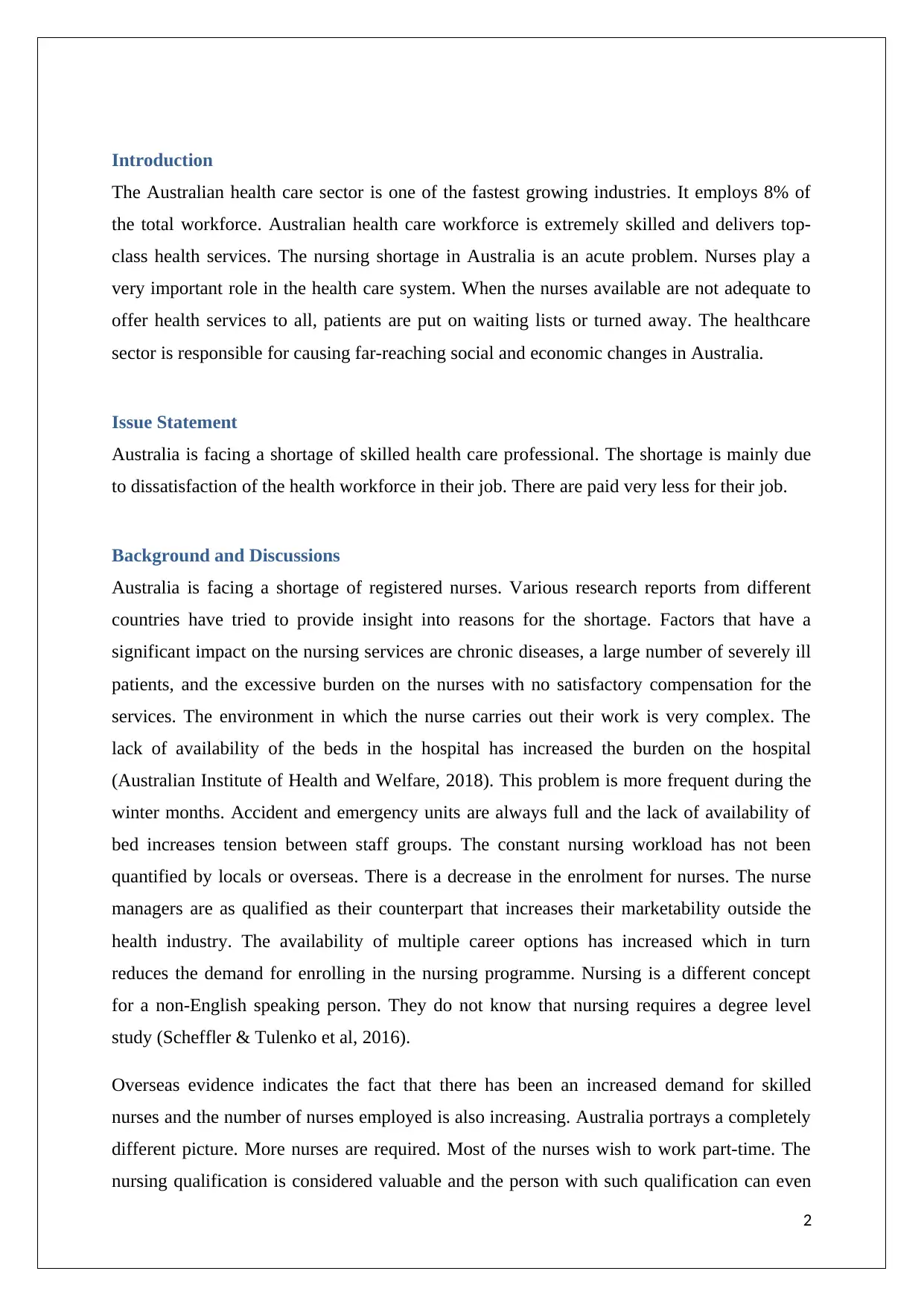
Introduction
The Australian health care sector is one of the fastest growing industries. It employs 8% of
the total workforce. Australian health care workforce is extremely skilled and delivers top-
class health services. The nursing shortage in Australia is an acute problem. Nurses play a
very important role in the health care system. When the nurses available are not adequate to
offer health services to all, patients are put on waiting lists or turned away. The healthcare
sector is responsible for causing far-reaching social and economic changes in Australia.
Issue Statement
Australia is facing a shortage of skilled health care professional. The shortage is mainly due
to dissatisfaction of the health workforce in their job. There are paid very less for their job.
Background and Discussions
Australia is facing a shortage of registered nurses. Various research reports from different
countries have tried to provide insight into reasons for the shortage. Factors that have a
significant impact on the nursing services are chronic diseases, a large number of severely ill
patients, and the excessive burden on the nurses with no satisfactory compensation for the
services. The environment in which the nurse carries out their work is very complex. The
lack of availability of the beds in the hospital has increased the burden on the hospital
(Australian Institute of Health and Welfare, 2018). This problem is more frequent during the
winter months. Accident and emergency units are always full and the lack of availability of
bed increases tension between staff groups. The constant nursing workload has not been
quantified by locals or overseas. There is a decrease in the enrolment for nurses. The nurse
managers are as qualified as their counterpart that increases their marketability outside the
health industry. The availability of multiple career options has increased which in turn
reduces the demand for enrolling in the nursing programme. Nursing is a different concept
for a non-English speaking person. They do not know that nursing requires a degree level
study (Scheffler & Tulenko et al, 2016).
Overseas evidence indicates the fact that there has been an increased demand for skilled
nurses and the number of nurses employed is also increasing. Australia portrays a completely
different picture. More nurses are required. Most of the nurses wish to work part-time. The
nursing qualification is considered valuable and the person with such qualification can even
2
The Australian health care sector is one of the fastest growing industries. It employs 8% of
the total workforce. Australian health care workforce is extremely skilled and delivers top-
class health services. The nursing shortage in Australia is an acute problem. Nurses play a
very important role in the health care system. When the nurses available are not adequate to
offer health services to all, patients are put on waiting lists or turned away. The healthcare
sector is responsible for causing far-reaching social and economic changes in Australia.
Issue Statement
Australia is facing a shortage of skilled health care professional. The shortage is mainly due
to dissatisfaction of the health workforce in their job. There are paid very less for their job.
Background and Discussions
Australia is facing a shortage of registered nurses. Various research reports from different
countries have tried to provide insight into reasons for the shortage. Factors that have a
significant impact on the nursing services are chronic diseases, a large number of severely ill
patients, and the excessive burden on the nurses with no satisfactory compensation for the
services. The environment in which the nurse carries out their work is very complex. The
lack of availability of the beds in the hospital has increased the burden on the hospital
(Australian Institute of Health and Welfare, 2018). This problem is more frequent during the
winter months. Accident and emergency units are always full and the lack of availability of
bed increases tension between staff groups. The constant nursing workload has not been
quantified by locals or overseas. There is a decrease in the enrolment for nurses. The nurse
managers are as qualified as their counterpart that increases their marketability outside the
health industry. The availability of multiple career options has increased which in turn
reduces the demand for enrolling in the nursing programme. Nursing is a different concept
for a non-English speaking person. They do not know that nursing requires a degree level
study (Scheffler & Tulenko et al, 2016).
Overseas evidence indicates the fact that there has been an increased demand for skilled
nurses and the number of nurses employed is also increasing. Australia portrays a completely
different picture. More nurses are required. Most of the nurses wish to work part-time. The
nursing qualification is considered valuable and the person with such qualification can even
2
⊘ This is a preview!⊘
Do you want full access?
Subscribe today to unlock all pages.

Trusted by 1+ million students worldwide
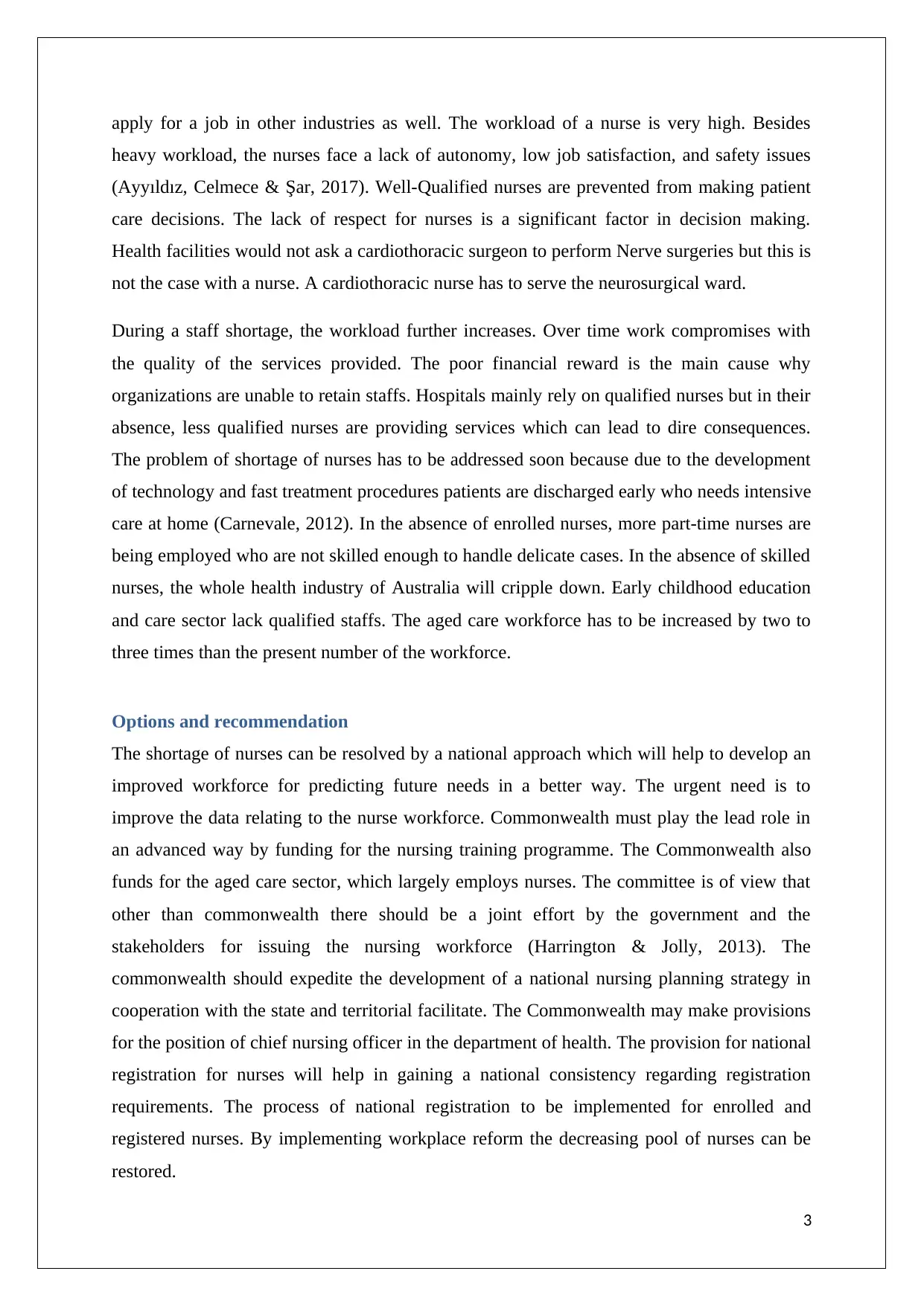
apply for a job in other industries as well. The workload of a nurse is very high. Besides
heavy workload, the nurses face a lack of autonomy, low job satisfaction, and safety issues
(Ayyıldız, Celmece & Şar, 2017). Well-Qualified nurses are prevented from making patient
care decisions. The lack of respect for nurses is a significant factor in decision making.
Health facilities would not ask a cardiothoracic surgeon to perform Nerve surgeries but this is
not the case with a nurse. A cardiothoracic nurse has to serve the neurosurgical ward.
During a staff shortage, the workload further increases. Over time work compromises with
the quality of the services provided. The poor financial reward is the main cause why
organizations are unable to retain staffs. Hospitals mainly rely on qualified nurses but in their
absence, less qualified nurses are providing services which can lead to dire consequences.
The problem of shortage of nurses has to be addressed soon because due to the development
of technology and fast treatment procedures patients are discharged early who needs intensive
care at home (Carnevale, 2012). In the absence of enrolled nurses, more part-time nurses are
being employed who are not skilled enough to handle delicate cases. In the absence of skilled
nurses, the whole health industry of Australia will cripple down. Early childhood education
and care sector lack qualified staffs. The aged care workforce has to be increased by two to
three times than the present number of the workforce.
Options and recommendation
The shortage of nurses can be resolved by a national approach which will help to develop an
improved workforce for predicting future needs in a better way. The urgent need is to
improve the data relating to the nurse workforce. Commonwealth must play the lead role in
an advanced way by funding for the nursing training programme. The Commonwealth also
funds for the aged care sector, which largely employs nurses. The committee is of view that
other than commonwealth there should be a joint effort by the government and the
stakeholders for issuing the nursing workforce (Harrington & Jolly, 2013). The
commonwealth should expedite the development of a national nursing planning strategy in
cooperation with the state and territorial facilitate. The Commonwealth may make provisions
for the position of chief nursing officer in the department of health. The provision for national
registration for nurses will help in gaining a national consistency regarding registration
requirements. The process of national registration to be implemented for enrolled and
registered nurses. By implementing workplace reform the decreasing pool of nurses can be
restored.
3
heavy workload, the nurses face a lack of autonomy, low job satisfaction, and safety issues
(Ayyıldız, Celmece & Şar, 2017). Well-Qualified nurses are prevented from making patient
care decisions. The lack of respect for nurses is a significant factor in decision making.
Health facilities would not ask a cardiothoracic surgeon to perform Nerve surgeries but this is
not the case with a nurse. A cardiothoracic nurse has to serve the neurosurgical ward.
During a staff shortage, the workload further increases. Over time work compromises with
the quality of the services provided. The poor financial reward is the main cause why
organizations are unable to retain staffs. Hospitals mainly rely on qualified nurses but in their
absence, less qualified nurses are providing services which can lead to dire consequences.
The problem of shortage of nurses has to be addressed soon because due to the development
of technology and fast treatment procedures patients are discharged early who needs intensive
care at home (Carnevale, 2012). In the absence of enrolled nurses, more part-time nurses are
being employed who are not skilled enough to handle delicate cases. In the absence of skilled
nurses, the whole health industry of Australia will cripple down. Early childhood education
and care sector lack qualified staffs. The aged care workforce has to be increased by two to
three times than the present number of the workforce.
Options and recommendation
The shortage of nurses can be resolved by a national approach which will help to develop an
improved workforce for predicting future needs in a better way. The urgent need is to
improve the data relating to the nurse workforce. Commonwealth must play the lead role in
an advanced way by funding for the nursing training programme. The Commonwealth also
funds for the aged care sector, which largely employs nurses. The committee is of view that
other than commonwealth there should be a joint effort by the government and the
stakeholders for issuing the nursing workforce (Harrington & Jolly, 2013). The
commonwealth should expedite the development of a national nursing planning strategy in
cooperation with the state and territorial facilitate. The Commonwealth may make provisions
for the position of chief nursing officer in the department of health. The provision for national
registration for nurses will help in gaining a national consistency regarding registration
requirements. The process of national registration to be implemented for enrolled and
registered nurses. By implementing workplace reform the decreasing pool of nurses can be
restored.
3
Paraphrase This Document
Need a fresh take? Get an instant paraphrase of this document with our AI Paraphraser
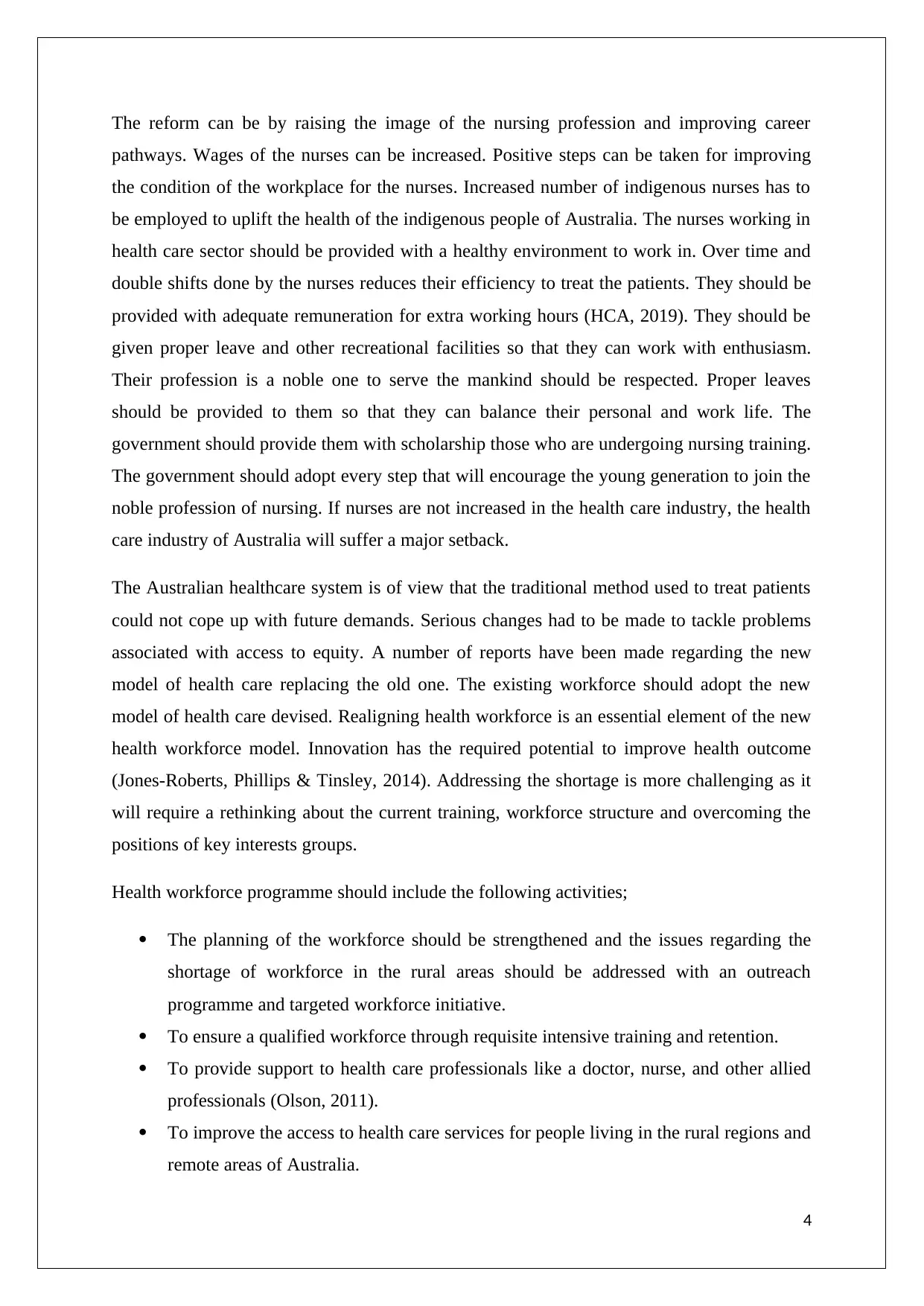
The reform can be by raising the image of the nursing profession and improving career
pathways. Wages of the nurses can be increased. Positive steps can be taken for improving
the condition of the workplace for the nurses. Increased number of indigenous nurses has to
be employed to uplift the health of the indigenous people of Australia. The nurses working in
health care sector should be provided with a healthy environment to work in. Over time and
double shifts done by the nurses reduces their efficiency to treat the patients. They should be
provided with adequate remuneration for extra working hours (HCA, 2019). They should be
given proper leave and other recreational facilities so that they can work with enthusiasm.
Their profession is a noble one to serve the mankind should be respected. Proper leaves
should be provided to them so that they can balance their personal and work life. The
government should provide them with scholarship those who are undergoing nursing training.
The government should adopt every step that will encourage the young generation to join the
noble profession of nursing. If nurses are not increased in the health care industry, the health
care industry of Australia will suffer a major setback.
The Australian healthcare system is of view that the traditional method used to treat patients
could not cope up with future demands. Serious changes had to be made to tackle problems
associated with access to equity. A number of reports have been made regarding the new
model of health care replacing the old one. The existing workforce should adopt the new
model of health care devised. Realigning health workforce is an essential element of the new
health workforce model. Innovation has the required potential to improve health outcome
(Jones-Roberts, Phillips & Tinsley, 2014). Addressing the shortage is more challenging as it
will require a rethinking about the current training, workforce structure and overcoming the
positions of key interests groups.
Health workforce programme should include the following activities;
The planning of the workforce should be strengthened and the issues regarding the
shortage of workforce in the rural areas should be addressed with an outreach
programme and targeted workforce initiative.
To ensure a qualified workforce through requisite intensive training and retention.
To provide support to health care professionals like a doctor, nurse, and other allied
professionals (Olson, 2011).
To improve the access to health care services for people living in the rural regions and
remote areas of Australia.
4
pathways. Wages of the nurses can be increased. Positive steps can be taken for improving
the condition of the workplace for the nurses. Increased number of indigenous nurses has to
be employed to uplift the health of the indigenous people of Australia. The nurses working in
health care sector should be provided with a healthy environment to work in. Over time and
double shifts done by the nurses reduces their efficiency to treat the patients. They should be
provided with adequate remuneration for extra working hours (HCA, 2019). They should be
given proper leave and other recreational facilities so that they can work with enthusiasm.
Their profession is a noble one to serve the mankind should be respected. Proper leaves
should be provided to them so that they can balance their personal and work life. The
government should provide them with scholarship those who are undergoing nursing training.
The government should adopt every step that will encourage the young generation to join the
noble profession of nursing. If nurses are not increased in the health care industry, the health
care industry of Australia will suffer a major setback.
The Australian healthcare system is of view that the traditional method used to treat patients
could not cope up with future demands. Serious changes had to be made to tackle problems
associated with access to equity. A number of reports have been made regarding the new
model of health care replacing the old one. The existing workforce should adopt the new
model of health care devised. Realigning health workforce is an essential element of the new
health workforce model. Innovation has the required potential to improve health outcome
(Jones-Roberts, Phillips & Tinsley, 2014). Addressing the shortage is more challenging as it
will require a rethinking about the current training, workforce structure and overcoming the
positions of key interests groups.
Health workforce programme should include the following activities;
The planning of the workforce should be strengthened and the issues regarding the
shortage of workforce in the rural areas should be addressed with an outreach
programme and targeted workforce initiative.
To ensure a qualified workforce through requisite intensive training and retention.
To provide support to health care professionals like a doctor, nurse, and other allied
professionals (Olson, 2011).
To improve the access to health care services for people living in the rural regions and
remote areas of Australia.
4
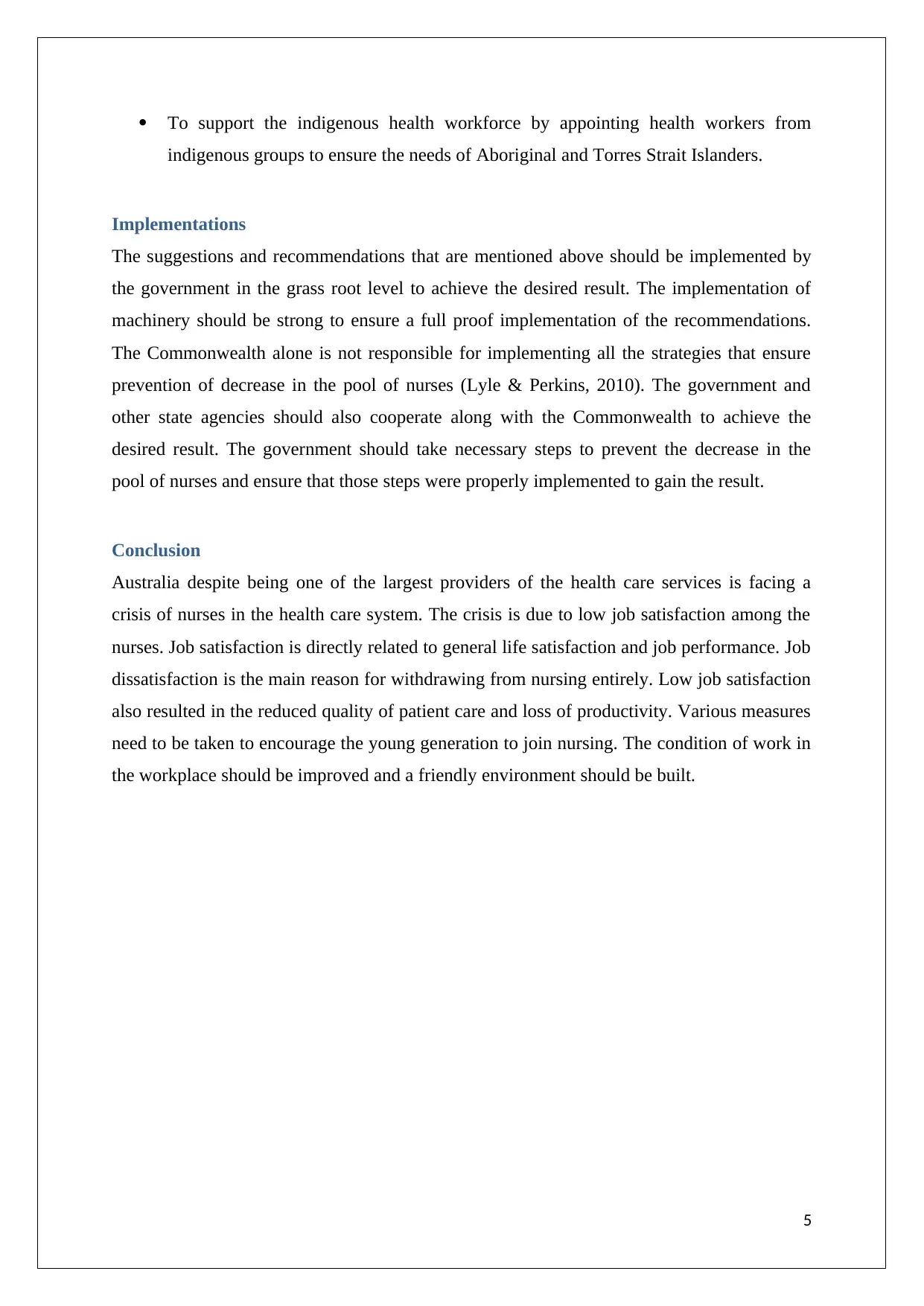
To support the indigenous health workforce by appointing health workers from
indigenous groups to ensure the needs of Aboriginal and Torres Strait Islanders.
Implementations
The suggestions and recommendations that are mentioned above should be implemented by
the government in the grass root level to achieve the desired result. The implementation of
machinery should be strong to ensure a full proof implementation of the recommendations.
The Commonwealth alone is not responsible for implementing all the strategies that ensure
prevention of decrease in the pool of nurses (Lyle & Perkins, 2010). The government and
other state agencies should also cooperate along with the Commonwealth to achieve the
desired result. The government should take necessary steps to prevent the decrease in the
pool of nurses and ensure that those steps were properly implemented to gain the result.
Conclusion
Australia despite being one of the largest providers of the health care services is facing a
crisis of nurses in the health care system. The crisis is due to low job satisfaction among the
nurses. Job satisfaction is directly related to general life satisfaction and job performance. Job
dissatisfaction is the main reason for withdrawing from nursing entirely. Low job satisfaction
also resulted in the reduced quality of patient care and loss of productivity. Various measures
need to be taken to encourage the young generation to join nursing. The condition of work in
the workplace should be improved and a friendly environment should be built.
5
indigenous groups to ensure the needs of Aboriginal and Torres Strait Islanders.
Implementations
The suggestions and recommendations that are mentioned above should be implemented by
the government in the grass root level to achieve the desired result. The implementation of
machinery should be strong to ensure a full proof implementation of the recommendations.
The Commonwealth alone is not responsible for implementing all the strategies that ensure
prevention of decrease in the pool of nurses (Lyle & Perkins, 2010). The government and
other state agencies should also cooperate along with the Commonwealth to achieve the
desired result. The government should take necessary steps to prevent the decrease in the
pool of nurses and ensure that those steps were properly implemented to gain the result.
Conclusion
Australia despite being one of the largest providers of the health care services is facing a
crisis of nurses in the health care system. The crisis is due to low job satisfaction among the
nurses. Job satisfaction is directly related to general life satisfaction and job performance. Job
dissatisfaction is the main reason for withdrawing from nursing entirely. Low job satisfaction
also resulted in the reduced quality of patient care and loss of productivity. Various measures
need to be taken to encourage the young generation to join nursing. The condition of work in
the workplace should be improved and a friendly environment should be built.
5
⊘ This is a preview!⊘
Do you want full access?
Subscribe today to unlock all pages.

Trusted by 1+ million students worldwide
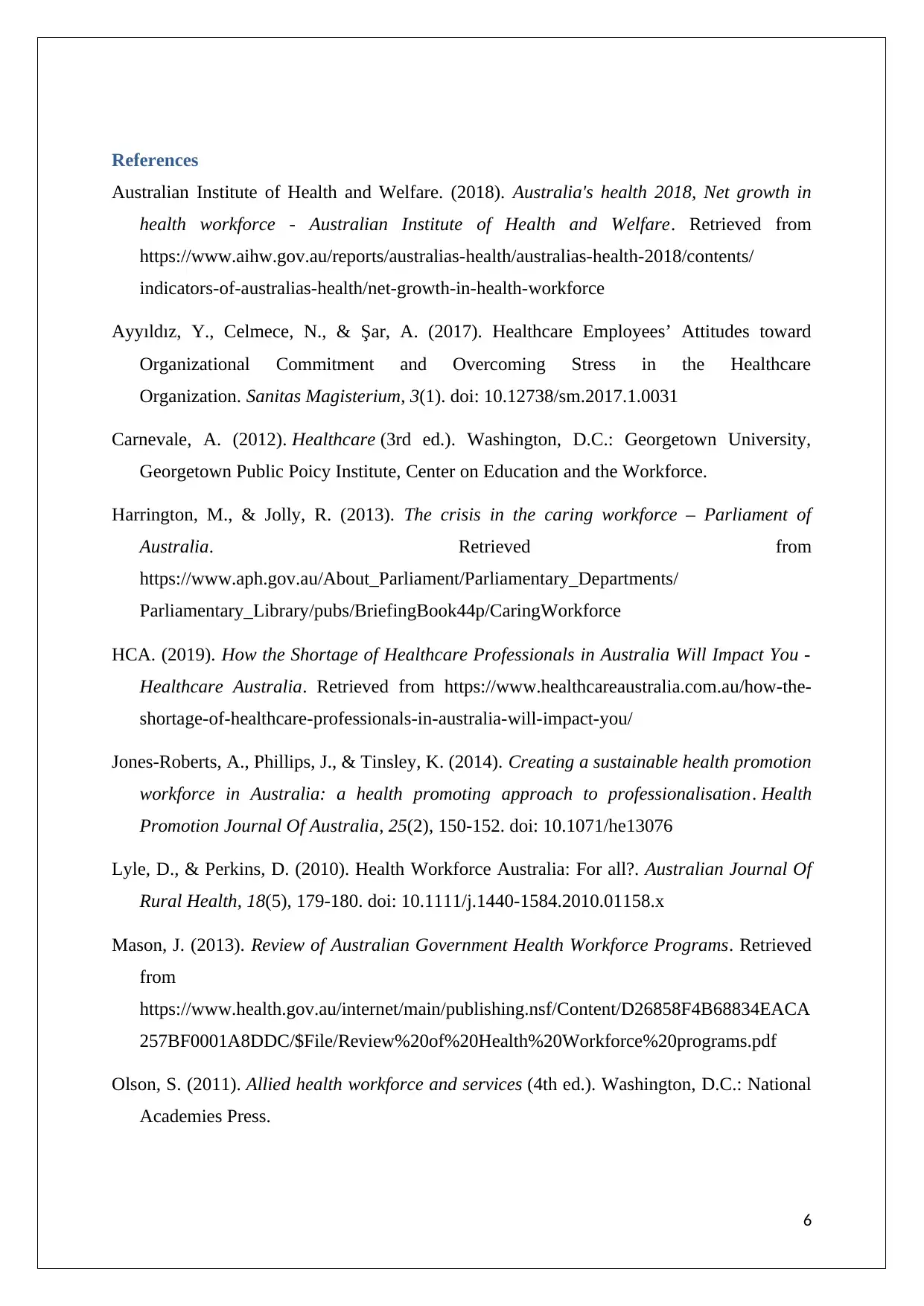
References
Australian Institute of Health and Welfare. (2018). Australia's health 2018, Net growth in
health workforce - Australian Institute of Health and Welfare. Retrieved from
https://www.aihw.gov.au/reports/australias-health/australias-health-2018/contents/
indicators-of-australias-health/net-growth-in-health-workforce
Ayyıldız, Y., Celmece, N., & Şar, A. (2017). Healthcare Employees’ Attitudes toward
Organizational Commitment and Overcoming Stress in the Healthcare
Organization. Sanitas Magisterium, 3(1). doi: 10.12738/sm.2017.1.0031
Carnevale, A. (2012). Healthcare (3rd ed.). Washington, D.C.: Georgetown University,
Georgetown Public Poicy Institute, Center on Education and the Workforce.
Harrington, M., & Jolly, R. (2013). The crisis in the caring workforce – Parliament of
Australia. Retrieved from
https://www.aph.gov.au/About_Parliament/Parliamentary_Departments/
Parliamentary_Library/pubs/BriefingBook44p/CaringWorkforce
HCA. (2019). How the Shortage of Healthcare Professionals in Australia Will Impact You -
Healthcare Australia. Retrieved from https://www.healthcareaustralia.com.au/how-the-
shortage-of-healthcare-professionals-in-australia-will-impact-you/
Jones-Roberts, A., Phillips, J., & Tinsley, K. (2014). Creating a sustainable health promotion
workforce in Australia: a health promoting approach to professionalisation. Health
Promotion Journal Of Australia, 25(2), 150-152. doi: 10.1071/he13076
Lyle, D., & Perkins, D. (2010). Health Workforce Australia: For all?. Australian Journal Of
Rural Health, 18(5), 179-180. doi: 10.1111/j.1440-1584.2010.01158.x
Mason, J. (2013). Review of Australian Government Health Workforce Programs. Retrieved
from
https://www.health.gov.au/internet/main/publishing.nsf/Content/D26858F4B68834EACA
257BF0001A8DDC/$File/Review%20of%20Health%20Workforce%20programs.pdf
Olson, S. (2011). Allied health workforce and services (4th ed.). Washington, D.C.: National
Academies Press.
6
Australian Institute of Health and Welfare. (2018). Australia's health 2018, Net growth in
health workforce - Australian Institute of Health and Welfare. Retrieved from
https://www.aihw.gov.au/reports/australias-health/australias-health-2018/contents/
indicators-of-australias-health/net-growth-in-health-workforce
Ayyıldız, Y., Celmece, N., & Şar, A. (2017). Healthcare Employees’ Attitudes toward
Organizational Commitment and Overcoming Stress in the Healthcare
Organization. Sanitas Magisterium, 3(1). doi: 10.12738/sm.2017.1.0031
Carnevale, A. (2012). Healthcare (3rd ed.). Washington, D.C.: Georgetown University,
Georgetown Public Poicy Institute, Center on Education and the Workforce.
Harrington, M., & Jolly, R. (2013). The crisis in the caring workforce – Parliament of
Australia. Retrieved from
https://www.aph.gov.au/About_Parliament/Parliamentary_Departments/
Parliamentary_Library/pubs/BriefingBook44p/CaringWorkforce
HCA. (2019). How the Shortage of Healthcare Professionals in Australia Will Impact You -
Healthcare Australia. Retrieved from https://www.healthcareaustralia.com.au/how-the-
shortage-of-healthcare-professionals-in-australia-will-impact-you/
Jones-Roberts, A., Phillips, J., & Tinsley, K. (2014). Creating a sustainable health promotion
workforce in Australia: a health promoting approach to professionalisation. Health
Promotion Journal Of Australia, 25(2), 150-152. doi: 10.1071/he13076
Lyle, D., & Perkins, D. (2010). Health Workforce Australia: For all?. Australian Journal Of
Rural Health, 18(5), 179-180. doi: 10.1111/j.1440-1584.2010.01158.x
Mason, J. (2013). Review of Australian Government Health Workforce Programs. Retrieved
from
https://www.health.gov.au/internet/main/publishing.nsf/Content/D26858F4B68834EACA
257BF0001A8DDC/$File/Review%20of%20Health%20Workforce%20programs.pdf
Olson, S. (2011). Allied health workforce and services (4th ed.). Washington, D.C.: National
Academies Press.
6
Paraphrase This Document
Need a fresh take? Get an instant paraphrase of this document with our AI Paraphraser
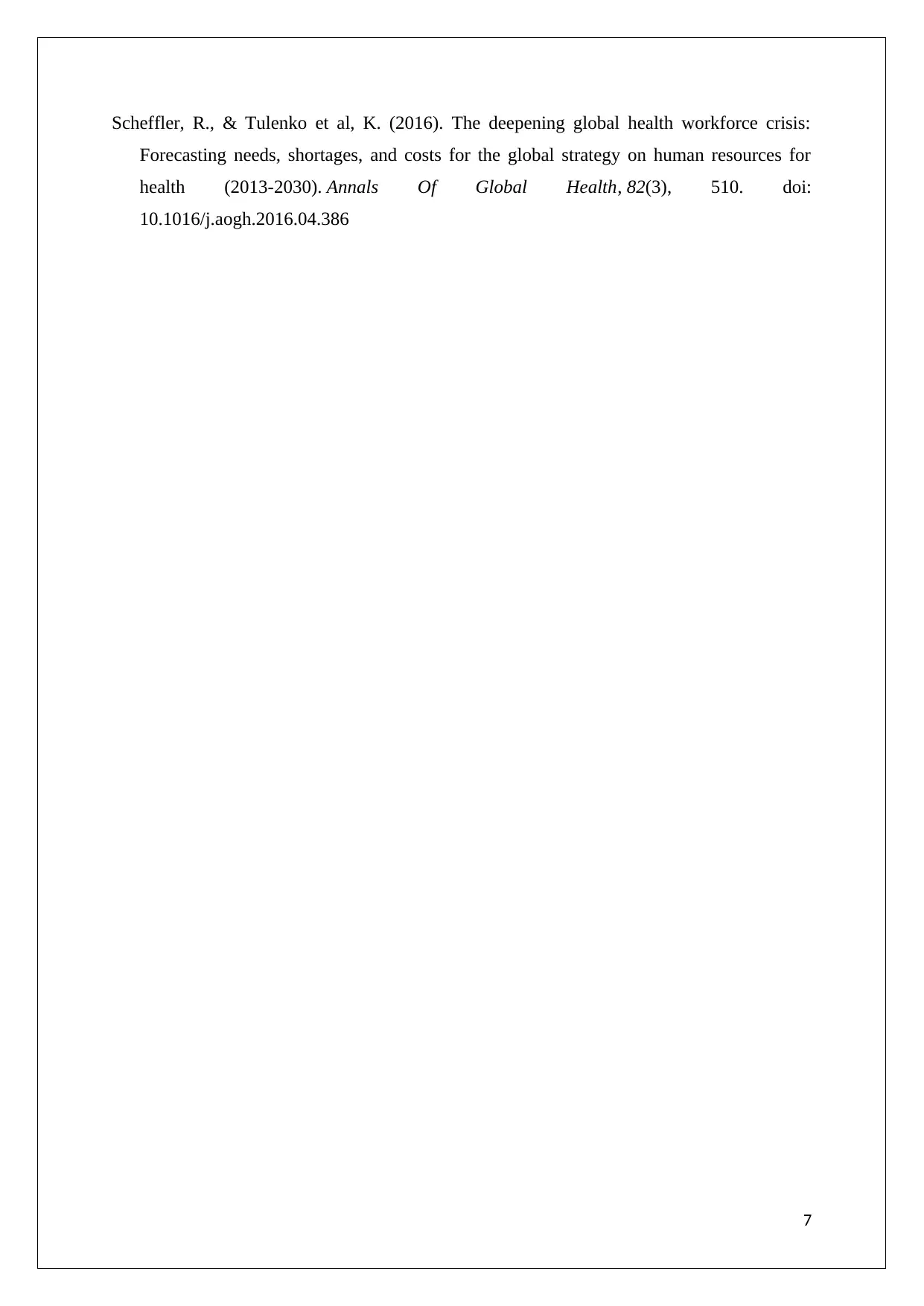
Scheffler, R., & Tulenko et al, K. (2016). The deepening global health workforce crisis:
Forecasting needs, shortages, and costs for the global strategy on human resources for
health (2013-2030). Annals Of Global Health, 82(3), 510. doi:
10.1016/j.aogh.2016.04.386
7
Forecasting needs, shortages, and costs for the global strategy on human resources for
health (2013-2030). Annals Of Global Health, 82(3), 510. doi:
10.1016/j.aogh.2016.04.386
7
1 out of 8
Related Documents
Your All-in-One AI-Powered Toolkit for Academic Success.
+13062052269
info@desklib.com
Available 24*7 on WhatsApp / Email
![[object Object]](/_next/static/media/star-bottom.7253800d.svg)
Unlock your academic potential
Copyright © 2020–2025 A2Z Services. All Rights Reserved. Developed and managed by ZUCOL.





